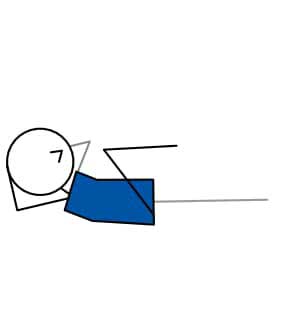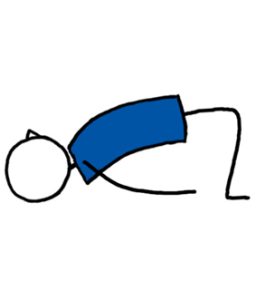
| Category: | Yoga Lesson Planner |
|---|---|
| Sub Category: | Seated & Floor |
| Types: | Balance, Hip Opener, Object, Seated & Floor, Stretch, Supine |
| Anatomy: | Arms & Shoulders, Biceps & Triceps, Core, Hamstrings, Hips, Lower Back, Middle Back, Psoas, Wrists & Arms |
| Chakras: | Base, Sacral Centre |
| Therapy: | Elderly People, Leg Congestion, Varicose Veins |
| Drishti: | Up |
| Dosha: | Kapha, Pitta |
Lie on your back with hands behind your head. Lift both legs, and engage your core. Bring one knee towards your chest while twisting your upper body, alternating sides in a bicycling motion, coordinating breath with movement. Maintain form, avoid neck strain, and focus on core engagement.
Strengthen the core. Improve abdominal definition. Engages oblique muscles. Promotes a healthier lower back.
A) Eye Of The Needle. B) Reverse Bicycle Kicks: Lie on your back, lift your legs, and mimic a backward biking motion. C) High-Intensity Bicycle Kicks: Move at a rapid pace to elevate your heart rate. D) Plank Bicycle Kicks: Start in a forearm plank position and draw your right knee toward your left elbow, then switch sides.
Neck strain.
Click here for lots of FREE downloadable Yoga lesson plans.
Click here for lots of FREE downloadable Pilates lesson plans.
- Manipura Chakra Fire Element
- Core flexibility
- Nov 20
- Open space, open heart
- 193, Zoom
- Body Awareness Week 2
- 199, Zoom
- Energy rising
- Hatha for E1B
- Body Awareness week 7
- Body awareness week 8
- Peak Pose Warrior III Mum&Daughter
- Core
- June 2024 Intermediate Soulful Yoga (Vinyasa?)
- Ask Genie 1
- 214, Zoom F
- June 2024 Intermediate Soulful Yoga (Vinyasa?)
- Ask Genie 1
- June 2024 Intermediate Soulful Yoga (Vinyasa?)
- U3A Yoga - Lesson 4 - 24/3/25 - Spine
- Beginning Chair Yoga Lesson 2
- 28 April 2025
- 12 May 2025
- 19 May 2025
- poses1
- Ask Genie 1
- Body Awareness week 0
- pawanmuktasana 1,2,3
Mastering “Bicycle Kicks” Pose: A Comprehensive Teaching Guide for Yoga Teachers
Introduction
Yoga is not just about the traditional asanas. It’s also a holistic practice that encompasses a wide range of movements and exercises to enhance flexibility, strength, and balance. One such exercise that has gained popularity in both yoga and Pilates routines is the “Bicycle Kicks” pose.
This dynamic movement offers a powerful core workout while engaging the legs and promoting coordination.
In this comprehensive teaching guide, we will explore the benefits, alignment principles, teaching steps, variations, and key tips to help yoga teachers master and effectively teach the Bicycle Kicks pose to their students.
Let’s start with the benefits.
5 Benefits of Bicycle Kicks
Before diving into the teaching aspects, let’s understand why Bicycle Kicks are a valuable addition to any yoga or fitness class. Here are some of the benefits:
Benefit 1: Core Strength
Bicycle Kicks target the entire core, including the rectus abdominis, obliques, and transverse abdominis. This helps in developing a strong and toned midsection.
Benefit 2: Improved Flexibility
The fluid leg movements in Bicycle Kicks promote flexibility in the hip flexors, hamstrings, and quadriceps.
Benefit 3: Enhanced Coordination
Coordinating leg movements with upper body twists challenges the mind-body connection and improves coordination.
Benefit 4: Lower Back Support
A strong core, developed through Bicycle Kicks, can help alleviate lower back pain and improve posture.
Benefit 5: Calorie Burn
When incorporated into a high-intensity workout, Bicycle Kicks can aid in calorie-burning and weight management.
Now, let’s delve into the teaching aspect of Bicycle Kicks.
Teaching Bicycle Kicks Pose
Here’s a step-by-step guide to help you effectively instruct your students:
Step 1: Warm-up
Begin the class with a gentle warm-up to prepare the body for the upcoming movements. Warm-up exercises can include light stretches, breathing exercises, and a few rounds of Cat-Cow to loosen up the spine.
Step 2: Explanation
Explain the benefits of Bicycle Kicks and the muscle groups they target. Emphasize the importance of proper form to prevent strain or injury.
Step 3: Demonstration
Perform Bicycle Kicks yourself to demonstrate the correct technique. Show both the leg movements and the upper body twist. Pay attention to maintaining a steady pace and controlled movements.
Step 4: Cue Proper Alignment
As your students prepare to practice Bicycle Kicks, provide verbal cues for proper alignment:
Lie on your back with hands interlaced behind your head.
Lift your legs off the ground, knees bent at a 90-degree angle.
Engage your core to support your lower back.
As you bring your right knee toward your chest, twist your upper body to the left, bringing your left elbow toward your right knee.
Alternate sides, moving in a pedalling motion.
Breathe deeply and coordinate your breath with the movement, inhaling as you bring a knee toward your chest and exhaling as you extend the leg away.
Step 5: Practice
Guide your students through a few rounds of Bicycle Kicks, ensuring they focus on maintaining proper form and coordinating their breath with the movement. Encourage them to start with a slow and controlled pace.
Step 6: Gradual Intensification
After students become comfortable with the basic Bicycle Kicks, you can gradually intensify the practice:
Option 1: Increase the speed of the movement for a cardiovascular challenge.
Option 2: Encourage students to extend their legs farther from their bodies, lowering them toward the ground without compromising form.
Step 7: Cool Down
Conclude the Bicycle Kicks practice with a gentle cool-down. Lead your students through some stretches, such as a gentle Butterfly Twist or Child Pose, to release any tension in the core and back.
Step 8: Safety Reminders
Remind your students to prioritize safety throughout the practice:
Safety Reminder 1: Avoid pulling on the neck or straining the lower back.
Safety Reminder 2: Listen to their bodies and modify the pose as needed.
Safety Reminder 3: Emphasize that progress takes time, and it’s essential to start at a comfortable pace.
5 Variations of Bicycle Kicks
To keep your classes engaging and cater to different skill levels, consider introducing variations of the Bicycle Kicks pose. Here are five variations with brief descriptions:
Variation 1: Reverse Bicycle Kicks
Lie on your back and lift your legs.
Perform a backward pedalling motion by drawing one knee toward your chest while twisting the upper body in the opposite direction.
This variation intensifies the focus on the lower abs and provides a unique challenge.
Variation 2: Weighted Bicycle Kicks
Hold a dumbbell or a weighted ball between your feet.
As you perform Bicycle Kicks, the added resistance increases the workout’s intensity, making it excellent for building strength and muscle engagement.
Variation 3: High-Intensity Bicycle Kicks
Speed up the Bicycle Kicks, moving at a rapid pace.
This high-intensity variation elevates the heart rate, turning it into a cardio workout while maintaining core engagement.
Variation 4: Plank Bicycle Kicks
Start in a forearm plank position.
Draw one knee toward the opposite elbow in a Bicycle Kicks motion.
This variation enhances core stability and targets the obliques.
Variation 5: Bicycle Kicks on a Stability Ball
Place your lower back on a stability ball.
Lift your legs and perform Bicycle Kicks.
Balancing on the ball engages core control and challenges balance, providing a full-body workout.
5 Tips for Teaching Bicycle Kicks
To ensure an effective and safe teaching experience, consider these key tips:
Tip 1: Proper Alignment
Emphasize the importance of maintaining proper form, such as avoiding neck strain and keeping the core engaged throughout the movement.
Tip 2: Breath Awareness
Remind students to coordinate their breath with the movement, inhaling as they bring a knee toward their chest and exhaling as they extend the leg away.
Tip 3: Start Slow
Encourage beginners to start with slow and controlled movements, gradually increasing the pace as they become more comfortable.
Tip 4: Modify as Needed
Remind students that it’s perfectly acceptable to modify the exercise based on their fitness level and any physical limitations.
Tip 5: Focus on Quality
Stress the importance of quality over quantity. It’s better to perform fewer repetitions with proper form than to rush through the exercise.
17 Yoga Class Themes For Bicycle Kicks
Here are 20 yoga class themes that you can use for the Bicycle Kicks pose to create meaningful and memorable experiences for your students:
Theme 1: Core Power
Emphasize core strength and stability, using Bicycle Kicks to build a strong centre.
Theme 2: Balancing Act
Explore the balance between effort and ease as you flow into Bicycle Kicks.
Theme 3: Finding Fluidity
Encourage fluid and controlled movements in Bicycle Kicks, promoting graceful transitions.
Theme 4: Breath and Movement
Connect breath to movement in Bicycle Kicks to enhance mindfulness and flow.
Theme 5: Strengthening the Center
Focus on the core as the centre of strength, stability, and energy in your practice.
Theme 6: Flowing Like Water
Promote fluidity and the sensation of moving like water as you cycle through Bicycle Kicks.
Theme 7: Inner Strength
Inspire students to tap into their inner strength and resilience during the practice.
Theme 8: Infinite Possibilities
Explore the endless variations of Bicycle Kicks to demonstrate the limitless potential within each individual (see variations below).
Theme 9: Unity of Body and Mind
Highlight the importance of synchronizing physical movements with mental focus and intention.
Theme 10: Breathe Through Challenges
Teach students to use their breath to navigate challenges in the practice.
Theme 11: Empowering the Core
Use Bicycle Kicks to empower the core, encouraging students to tap into their personal power.
Theme 12: Balance and Equilibrium
Discuss the concept of balance not only in the physical realm but also in life itself.
Theme 13: Joyful Movement
Celebrate the joy of movement as you flow into Bicycle Kicks, letting go of expectations and judgment.
Theme 14: Creating Space
Encourage students to create space in the body and mind through the opening of the hips in Bicycle Kicks.
Theme 15: Dancing with the Breath
Explore how the breath can feel like a dance when synchronized with movements like Bicycle Kicks.
Theme 16: Strength from Within
Emphasize that true strength comes from inner resilience and self-belief.
Theme 17: Building Resilience
Teach students to build physical and mental resilience by acknowledging that challenges in the practice are opportunities for growth.
Conclusion
The Bicycle Kicks pose is a versatile and effective exercise that targets the core muscles, improves flexibility, and enhances coordination.
As yoga teachers, it’s our responsibility to guide our students in mastering this pose while ensuring their safety and proper alignment. By following the steps outlined in this teaching guide, adding variations, and applying the teaching tips, you can help your students reap the numerous benefits of Bicycle Kicks and elevate their yoga practice to new heights.




 Yoga Lesson Planner
Yoga Lesson Planner
 Pilates Lesson Planner
Pilates Lesson Planner






